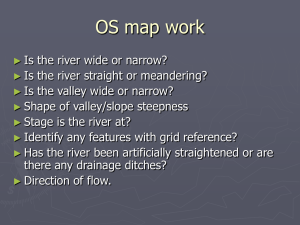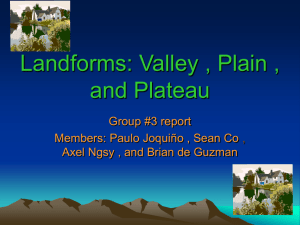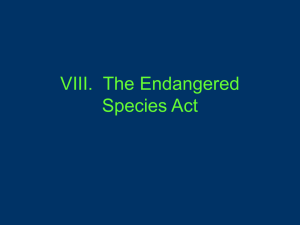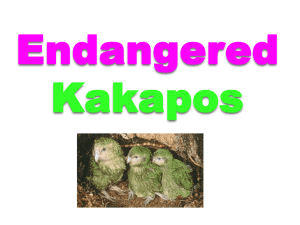Proposed Covered Species
advertisement
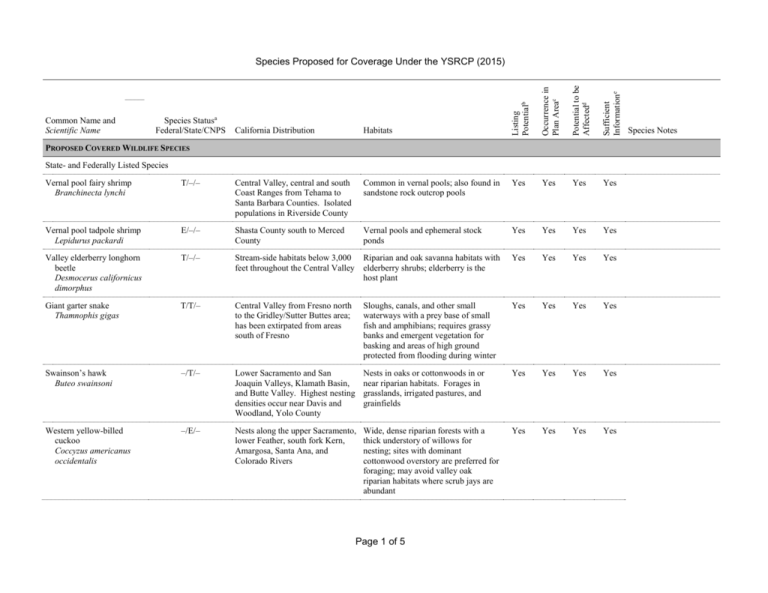
Listing Potentialb Occurrence in Plan Areac Potential to be Affectedd Sufficient Informatione Species Proposed for Coverage Under the YSRCP (2015) Vernal pool fairy shrimp Branchinecta lynchi T/–/– Central Valley, central and south Coast Ranges from Tehama to Santa Barbara Counties. Isolated populations in Riverside County Common in vernal pools; also found in sandstone rock outcrop pools Yes Yes Yes Yes Vernal pool tadpole shrimp Lepidurus packardi E/–/– Shasta County south to Merced County Vernal pools and ephemeral stock ponds Yes Yes Yes Yes Valley elderberry longhorn beetle Desmocerus californicus dimorphus T/–/– Stream-side habitats below 3,000 feet throughout the Central Valley Riparian and oak savanna habitats with elderberry shrubs; elderberry is the host plant Yes Yes Yes Yes Giant garter snake Thamnophis gigas T/T/– Central Valley from Fresno north to the Gridley/Sutter Buttes area; has been extirpated from areas south of Fresno Sloughs, canals, and other small waterways with a prey base of small fish and amphibians; requires grassy banks and emergent vegetation for basking and areas of high ground protected from flooding during winter Yes Yes Yes Yes Swainson’s hawk Buteo swainsoni –/T/– Lower Sacramento and San Joaquin Valleys, Klamath Basin, and Butte Valley. Highest nesting densities occur near Davis and Woodland, Yolo County Nests in oaks or cottonwoods in or near riparian habitats. Forages in grasslands, irrigated pastures, and grainfields Yes Yes Yes Yes Western yellow-billed cuckoo Coccyzus americanus occidentalis –/E/– Nests along the upper Sacramento, lower Feather, south fork Kern, Amargosa, Santa Ana, and Colorado Rivers Wide, dense riparian forests with a thick understory of willows for nesting; sites with dominant cottonwood overstory are preferred for foraging; may avoid valley oak riparian habitats where scrub jays are abundant Yes Yes Yes Yes Common Name and Scientific Name Species Statusa Federal/State/CNPS California Distribution Habitats PROPOSED COVERED WILDLIFE SPECIES State- and Federally Listed Species Page 1 of 5 Species Notes Sufficient Informatione –/T/– Potential to be Affectedd Bank swallow Riparia riparia Species Statusa Federal/State/CNPS Occurrence in Plan Areac Common Name and Scientific Name Listing Potentialb Species Proposed for Coverage Under the YSRCP (2015) Occurs along the Sacramento Nests in bluffs or banks, usually River from Tehama to Sacramento adjacent to water, where soil consists Counties; along the Feather and of sand or sandy loam lower American Rivers; in the Owens Valley; and in the plains east of the Cascade Range in Modoc, Lassen, and northern Siskiyou Counties. Small populations near the coast from San Francisco to Monterey Counties Yes Yes Yes Yes California Distribution Habitats Black rail Laterallus jamaicensis –/T, FP/– Permanent resident in the San Francisco Bay and east through the Delta into Sacramento and San Joaquin Counties; small populations in Marin, Santa Cruz, San Luis Obispo, Orange, Riverside, and Imperial Counties Tidal salt marshes associated with heavy growth of pickleweed; also occurs in brackish marshes or freshwater marshes at low elevations Yes Yes Yes Yes Greater sandhill crane Grus canadensis tabida –/T/– Breeds on the plains east of the Cascade Range and south to Sierra County; winters in the Central Valley, southern Imperial County, Lake Havasu National Wildlife Refuge, and the Colorado River Indian Reserve Summers in open terrain near shallow lakes or freshwater marshes; winters in plains and valleys near bodies of fresh water Yes Yes Yes Yes NON-LISTED SPECIAL-STATUS SPECIES Western spadefoot Scaphiopus hammondii –/SSC/– Sierra Nevada foothills, Central Valley, Coast Ranges, coastal counties in southern California Shallow streams with riffles; seasonal wetlands such as vernal pools in annual grasslands and oak woodlands Yes Yes Yes Yes Northwestern pond turtle Clemmys marmorata marmorata –/SSC/– Oregon border of Del Norte and Siskiyou Counties south along the coast to San Francisco Bay, inland through the Sacramento Valley, and on the western slope of Sierra Nevada Ponds, marshes, rivers, streams, and irrigation canals with muddy or rocky bottoms and with watercress, cattails, water lilies, or other aquatic vegetation in woodlands, grasslands, and open forests Yes Yes Yes Yes Page 2 of 5 Species Notes Listing Potentialb Occurrence in Plan Areac Potential to be Affectedd Sufficient Informatione Species Proposed for Coverage Under the YSRCP (2015) Western burrowing owl Athene cunicularia hypugea –/SSC/– Lowlands throughout California, including the Central Valley, northeastern plateau, southeastern deserts, and coastal areas. Rare along south coast Level, open, dry, heavily grazed or low-stature grassland or desert vegetation with available burrows Yes Yes Yes Yes Tricolored blackbird Agelaius tricolor –/SSCg/– Permanent resident in the Central Valley from Butte to Kern Counties. Breeds at scattered coastal locations from Marin to San Diego Counties and at scattered locations in Lake, Sonoma, and Solano Counties. Rare nester in Siskiyou, Modoc, and Lassen Counties Nests in dense colonies in emergent marsh vegetation, such as tules and cattails, or upland sites with blackberries, nettles, thistles, and grainfields. Habitat must be large enough to support 50 pairs. Probably requires water at or near the nesting colony Yes Yes Yes Yes Scattered occurrences concentrated in the eastern Sacramento Valley and the Modoc Plateau Vernal pools and shallow lake margins, 1- to 4000 feet Yes Unkn. Yes Yes Retained because of potential to occur in vernal pools. –/–/2.2 Inner Coast Ranges, Southern Sacramento Valley and northern and central San Joaquin Valley Vernal pools and swales, and wetland margins, < 500 feet Yes Yes Poss. No ?. –/–/1B.2 Eastern Sacramento Valley; northeastern San Joaquin Valley; Butte, Calaveras, Placer, Sacramento, and Yuba Counties Vernal pool margins, 100330 feet Yes Yes Yes Yes Common Name and Scientific Name Species Statusa Federal/State/CNPS California Distribution Habitats Species Notes PROPOSED COVERED PLANTS SPECIES STATE- AND FEDERALLY LISTED SPECIES Bogg’s Lake hedgehyssop Gratiola heterosepala –/E/1B.2 NON-LISTED SPECIAL-STATUS SPECIES Dwarf downingia Downingia pusilla Ahart’s dwarf rush Juncus leiospermus var. ahartii Page 3 of 5 –/–/1B.1 Habitats Coast and Cascade Ranges and Vernal pools, swales, seasonal Sacramento Valley marshes, and other seasonally inundated habitats, < 500 feet Page 4 of 5 Sufficient Informatione Legenere Legenere limosa California Distribution Potential to be Affectedd Species Statusa Federal/State/CNPS Occurrence in Plan Areac Common Name and Scientific Name Listing Potentialb Species Proposed for Coverage Under the YSRCP (2015) Yes No Yes Yes Species Notes Species Proposed for Coverage Under the YSRCP (2015) a Status Explanations: Federal E = listed as endangered under the federal Endangered Species Act (ESA). T = listed as threatened under the federal ESA. D = delisted – = no listing. State E = listed as endangered under the California ESA. T = listed as threatened under the California ESA. SSC = species of special concern. FP = fully protected – = no listing. R = listed as rare under the California Native Plant Protection Act. This category is no longer used for newly listed plants, but some plants previously listed as rare retain the designation. CNPS 1B = List 1B species: rare, threatened, or endangered in California and elsewhere. 2 = List 2 species: rare, threatened, or endangered in California but more common elsewhere. .1 = seriously endangered in California .2 = fairly endangered in California .3 = not very endangered in California b Listing Potential (No) (Yes) c Occurrence in Plan Area (No) (Yes) d Species is not currently state- or federally listed as threatened or endangered and has low potential of being listed during plan implementation. Species is currently federally listed as threatened or endangered, or has the potential to be federally listed as threatened or endangered during plan implementation. Plan area lacking suitable habitat or is outside species range; species unlikely to occur within plan area. Suitable habitat is present within the plan area; species may occur within plan area. Potential to be Affected (No) (Yes) Unlikely to be affected by covered activities Likely to be affected by covered activities e Sufficient Information f Proposed for Coverage Sufficient scientific information and data are available to address species’ biological requirements, conservation needs, and compensation options. Species are proposed for coverage if the following criteria are met: g the species is federally listed or has the potential to be listed in the next 30 years, the species has a moderate to high likelihood of occurring within the plan area, the species is likely to be affected by project activities, and sufficient information is available. Sufficient scientific information and data are available to address species’ biological requirements, conservation needs, and compensation options. Tricolored blackbird was granted emergency protection under CESA December 3, 2014 Page 5 of 5

